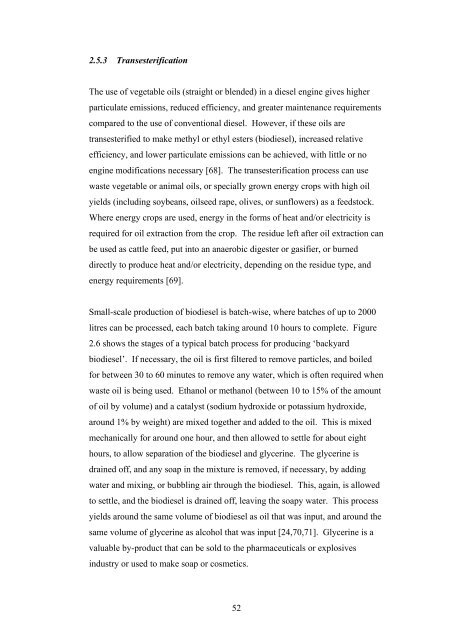PhD Thesis - Energy Systems Research Unit - University of Strathclyde
PhD Thesis - Energy Systems Research Unit - University of Strathclyde
PhD Thesis - Energy Systems Research Unit - University of Strathclyde
You also want an ePaper? Increase the reach of your titles
YUMPU automatically turns print PDFs into web optimized ePapers that Google loves.
2.5.3 Transesterification<br />
The use <strong>of</strong> vegetable oils (straight or blended) in a diesel engine gives higher<br />
particulate emissions, reduced efficiency, and greater maintenance requirements<br />
compared to the use <strong>of</strong> conventional diesel. However, if these oils are<br />
transesterified to make methyl or ethyl esters (biodiesel), increased relative<br />
efficiency, and lower particulate emissions can be achieved, with little or no<br />
engine modifications necessary [68]. The transesterification process can use<br />
waste vegetable or animal oils, or specially grown energy crops with high oil<br />
yields (including soybeans, oilseed rape, olives, or sunflowers) as a feedstock.<br />
Where energy crops are used, energy in the forms <strong>of</strong> heat and/or electricity is<br />
required for oil extraction from the crop. The residue left after oil extraction can<br />
be used as cattle feed, put into an anaerobic digester or gasifier, or burned<br />
directly to produce heat and/or electricity, depending on the residue type, and<br />
energy requirements [69].<br />
Small-scale production <strong>of</strong> biodiesel is batch-wise, where batches <strong>of</strong> up to 2000<br />
litres can be processed, each batch taking around 10 hours to complete. Figure<br />
2.6 shows the stages <strong>of</strong> a typical batch process for producing ‘backyard<br />
biodiesel’. If necessary, the oil is first filtered to remove particles, and boiled<br />
for between 30 to 60 minutes to remove any water, which is <strong>of</strong>ten required when<br />
waste oil is being used. Ethanol or methanol (between 10 to 15% <strong>of</strong> the amount<br />
<strong>of</strong> oil by volume) and a catalyst (sodium hydroxide or potassium hydroxide,<br />
around 1% by weight) are mixed together and added to the oil. This is mixed<br />
mechanically for around one hour, and then allowed to settle for about eight<br />
hours, to allow separation <strong>of</strong> the biodiesel and glycerine. The glycerine is<br />
drained <strong>of</strong>f, and any soap in the mixture is removed, if necessary, by adding<br />
water and mixing, or bubbling air through the biodiesel. This, again, is allowed<br />
to settle, and the biodiesel is drained <strong>of</strong>f, leaving the soapy water. This process<br />
yields around the same volume <strong>of</strong> biodiesel as oil that was input, and around the<br />
same volume <strong>of</strong> glycerine as alcohol that was input [24,70,71]. Glycerine is a<br />
valuable by-product that can be sold to the pharmaceuticals or explosives<br />
industry or used to make soap or cosmetics.<br />
52

















